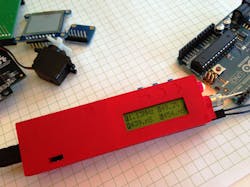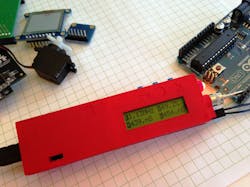Debug Tool Fills the Gap Between DMMs and Scopes
Mark Henderson of Long Beach, CA has started a “Kickstarter” program for a debug tool that he says, “will be the first tool you’ll use when chasing issues in your electronic product”. He calls it “tiq” and it is a special tester that provides fast, detailed information in an easy-to-handle probe.
Primarily a logic debug tool and voltmeter, it is intended for the debug of embedded electronics, including those with motors, servos and power supplies. Problems that arise are often in challenging places, so tiq even has a bright LED that illuminates the problem area.
Not only an analyzer, tiq provides a powerful programmable pulse generator so you can provide stimulus to circuits under test, or exercise a servo, motor or LED driver.
Simply touch tiq to a circuit and it instantly displays repetitive pulse activity and timing or detailed logic level analysis with voltage measurements. Fully automatic, no settings or adjustments are required. The information is on a crisp LCD screen close to the probe tip, augmented by LED colors and audible tones, so you don’t need to look away at a screen, risking dangerous probe slips.
Its features include:
· Perfect for microprocessor-based project test and debug
· For professionals, hobbyists, students, enthusiasts
· Handheld, it displays information close to the probe tip
· Logic level probe with LCD, LED and audible indicators (logic high at 3.3V or 5V, low or float)
· Logic pulse analyzer (frequency, pulse high and low time, duty cycle),frequency to 20 MHz, repetitive pulse analysis to <100 nS
· Auto-ranging and auto-polarity voltmeter (+28Vdc to -13 Vdc)
· Built-in logic pulse generator (<100 nS to 999 mS, n pulses or continuous, 3.3V or 5V logic level output)
· USB power connector – connect directly to your development PC, USB adapter or USB battery.
· Two additional grounding pins for connection to your circuit.
Henderson notes that has always been a gap in capabilities between the DMM, logic probe, scopes and analyzers. As an electronic hobbyist and professional he dreamed for decades about a compact probe that could give him fast and detailed information about circuits he was working on. His first, and most used tool, used to be a simple logic probe he built into a highlighter case 30 years ago. Henderson wondered how he could make something that would fill the gap between DMM probe and scope/analyzer, with good performance and low cost, and it fit into a convenient portable probe.
There have been attempts to fill these gaps in capability, and some are amazing – like a slew of low cost digital scopes – even on Kickstarter. As clever as these are, they are very limited in bandwidth, not fast enough for digital and microprocessor work, and even though they are small, they can’t display close to a probe tip.
Since the whole point of embedded electronics is to be buried in something else, we usually have to debug or test circuits in places where it is inconvenient or hard to get to. Compact, easy to hook up tools really save a lot of time.
Mark realized he didn’t want a small scope, he wanted a “logic probe on steroids - with some analog.” Then, along came the Cypress pSoC 5LP, a single chip with CPU, memory, configurable digital hardware, and configurable analog hardware. This, coupled a reasonable small display, rgb LEDs – could surely provide the answer.
So tiq was born. Henderson has been using prototypes for all his debug work since 2013, adding and improving features as he used them. Tiq has been through a couple of prototype stages, and now it is ready to launch (and start a line of tools specifically for modern embedded projects). Tiq is really a time saver. For example, tiq rev. 1 was used to debug itself and rev. 2.
Apart from fast and automatic logic and voltage measurements, circuits often need simulated pulse trains for debugging projects with multiple modules, sensors and motors. The power of the pSoC 5LP allows Henderson to build in a fully programmable digital pulse generator, capable of pulse bursts, or continuous streams of pulses, from nS to fractions of seconds wide.
About the Author

Sam Davis Blog
Editor-In-Chief - Power Electronics
Sam Davis was the editor-in-chief of Power Electronics Technology magazine and website that is now part of Electronic Design. He has 18 years experience in electronic engineering design and management, six years in public relations and 25 years as a trade press editor. He holds a BSEE from Case-Western Reserve University, and did graduate work at the same school and UCLA. Sam was the editor for PCIM, the predecessor to Power Electronics Technology, from 1984 to 2004. His engineering experience includes circuit and system design for Litton Systems, Bunker-Ramo, Rocketdyne, and Clevite Corporation.. Design tasks included analog circuits, display systems, power supplies, underwater ordnance systems, and test systems. He also served as a program manager for a Litton Systems Navy program.
Sam is the author of Computer Data Displays, a book published by Prentice-Hall in the U.S. and Japan in 1969. He is also a recipient of the Jesse Neal Award for trade press editorial excellence, and has one patent for naval ship construction that simplifies electronic system integration.

